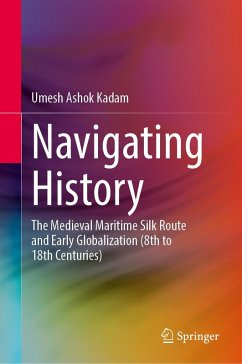This book explores the history of the Medieval Maritime Silk Route between the 4th and 17th Centuries CE as a dynamic network that facilitated extensive commercial exchange and profound cultural, political, and religious interactions across Eurasia and beyond. It examines how trade routes connected regions such as China, India, Southeast Asia, Southwest Asia, Africa, and parts of Europe, creating early forms of globalization driven by mutual economic interests.
Chapters delve into the ethnographic impact of diasporic communities, the transmission of architectural styles, navigational and maritime innovations, religious interactions, and linguistic and culinary traditions. This book also examines how political developments, including the policies of regional powers, played a crucial role in sustaining the network, and how the arrival of European colonial powers transformed its nature through monopoly and militarized trade. It provides an in-depth analysis of key maritime hubs, the role of technological advancements in navigation, and the socio-economic impacts of maritime trade on local communities. By integrating diverse perspectives and interdisciplinary approaches, this book offers a comprehensive understanding of the Medieval Maritime Silk Route s significance in shaping early global interactions.
This book is a must-read for those exploring the history of the medieval Maritime Silk Route. It serves as an invaluable resource for researchers, students, and readers with a keen interest in maritime history, transregional cultural exchange, and pre-modern globalization.
Chapters delve into the ethnographic impact of diasporic communities, the transmission of architectural styles, navigational and maritime innovations, religious interactions, and linguistic and culinary traditions. This book also examines how political developments, including the policies of regional powers, played a crucial role in sustaining the network, and how the arrival of European colonial powers transformed its nature through monopoly and militarized trade. It provides an in-depth analysis of key maritime hubs, the role of technological advancements in navigation, and the socio-economic impacts of maritime trade on local communities. By integrating diverse perspectives and interdisciplinary approaches, this book offers a comprehensive understanding of the Medieval Maritime Silk Route s significance in shaping early global interactions.
This book is a must-read for those exploring the history of the medieval Maritime Silk Route. It serves as an invaluable resource for researchers, students, and readers with a keen interest in maritime history, transregional cultural exchange, and pre-modern globalization.








